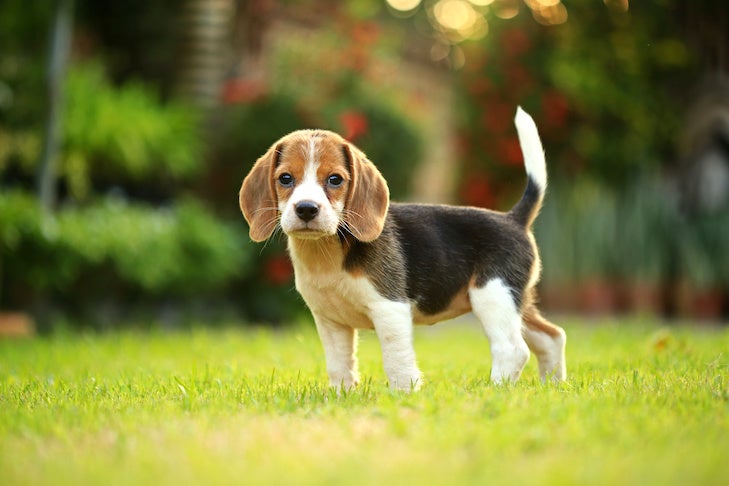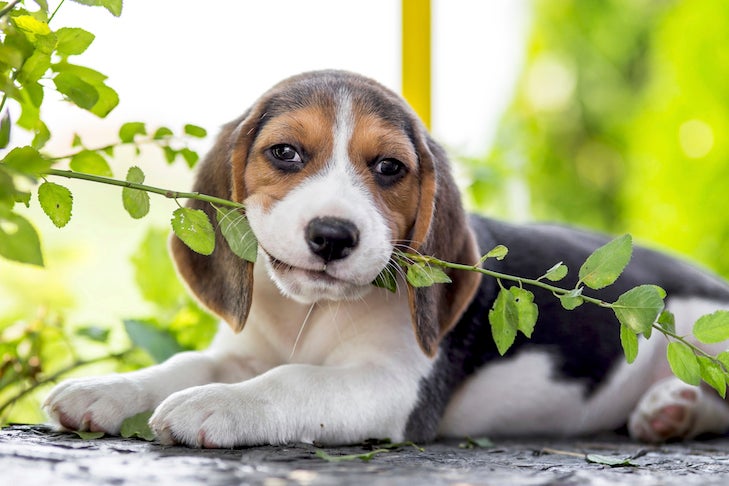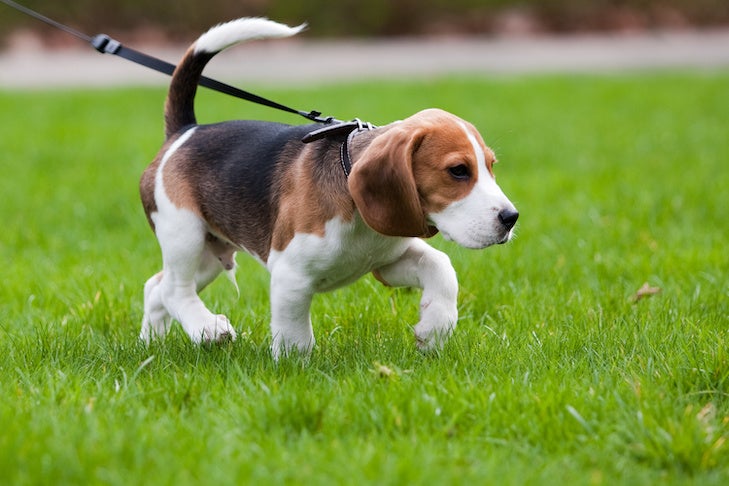
Beagles are known for their long ears, hunting skills, and happy-go-lucky attitude. But while they love companionship and are usually easygoing, their noses can get them into trouble.
Before you bring home your first Beagle puppy, it’s important to prepare.We talked to National Beagle Club Approved Mentor Lori Norman about major milestones for Beagles. Here’s what you should keep an eye on, and what training goals to hit.
Growth Stage: Between 8–16 weeks
Training goal #1: Socialize Beagles with other dogs and people
Beagles are friendly dogs who love spending time with others, including dogs and humans. When they’re young, you should expose your Beagle to new dogs, people, places, and situations like car rides and crates.
Socializing your Beagle is the key to raising a kind, confident, and well-adjusted dog. “Between eight and 16 weeks, the puppy should learn socialization skills, like getting used to different people, sounds, shapes, and sights,” says Norman.
Consider enrolling your pup in the AKC S.T.A.R. Puppy program where they can learn manners and socialize with others.
Training goal #2: Build confidence
In this stage, these pups are still babies and will act like it. But, around 12 weeks, they’ll start connecting the dots and learning from repetition. Norman explains that it’s essential to teach them to enjoy challenges, and to build confidence so they’re not afraid to try new things.
“Ensure that they grow into a confident adult,” she said. “It is important for them to learn how to learn, and enjoy the process.”
Training goal #3: Teach Beagles what to chew
If you’ve been around a puppy, you know they love to chew everything, especially when they’re teething. When your Beagle is a puppy, make sure you teach them what is OK to chew and what’s not.
“A puppy should only have access to what it is allowed to have, when unsupervised,” Norman says. “Under supervision, if you see a puppy chewing something he shouldn’t, then teach him, ‘Leave It!'”

Puppy stage: By 6 months
When your pup reaches this stage, they should know how to learn and listen when you tell them not to chew. However, Beagles are smart and still need supervision at this age.
Training goal #4: Teach basic commands and boundaries to your Beagle
Once your puppy has some confidence and knows how to learn, start training them basic commands such as “Sit” and “Stay.” Along with basic commands, it’s important to teach your Beagle boundaries.
“A puppy begins as a blank slate and acquires behavior based on an owner’s approval or disapproval,” says Norman. “It is important that the puppy learn what is expected, through consistent practices, and lots of positive reinforcement. Don’t waver on those boundaries.”
When your puppy observes boundaries, reward them. But, if they fail to meet a boundary, correct them, then offer praise when they redirect the behavior.
Training goal #5: Potty train and crate train your Beagle
Potty training your pup is an important milestone in their life. By six months, there is a good chance your Beagle is close to being potty-trained. “Their potty training depends on how diligent you’ve been on taking them out on a schedule to prevent mistakes inside,” Norman says. She adds that female Beagles typically take longer because they’re more likely to get UTIs between four and six months.
The key to potty training your dog is consistency, attention, patience, and understanding. When you’re potty training your dog, it’s recommended to take them out often—such as every hour on the hour—to the spot where you want your dog to do their business. You should also make sure they don’t eat or drink three to four hours before bedtime and take them on regular walks.
To learn more about potty training, check out this comprehensive guide.
Crate training your Beagle is also an important component to a happy dog. “Prevention is the best method when training a puppy,” Norman says. “If you aren’t there to watch them, they should be confined.”
Your Beagle will be much harder to live with if you skip this step. Like potty training, the key to this skill is repetition and consistency. “Crates allow everyone to sleep through the night without accidents or destruction. It keeps him safe and you happy,” she explains.
Training goal #6: Build core muscles
When you’re exercising, training, and playing with your Beagle, you’re also helping them build core muscles. Proper exercise is essential. Norman recommends avoiding too much jumping and being knocked around with rough play because the Beagle’s growth plates don’t close until close to a year old.
“While using judgment to avoid over-exercising, puppies should run and play,” she added. “Building the core muscles is required for overall good health and conditioning.”
Beagles are also energetic dogs and exercise helps keep the energy level down. Pent-up and bored puppies typically go looking for trouble.

Growth stage: By one year
By your puppy’s first birthday, they should know basic commands and have a daily routine.
Training goal #7: Get your Beagle involved in AKC activities
Beagles can participate in a variety of AKC activities including tracking, obedience, and agility. With a Beagle’s keen sense of smell, they’re great hunting companions and excel in Beagle Hound Field Trials. During the trial, your pup is judged on their ability to search and explore, as well as endurance, determination, etc.
Regardless of the activity, you should get your pup involved and do it together. “They love family outings and being part of the family, but don’t like just sitting idle. They need a job,” Norman says. “Any performance event, play-time, or special training exercise you work on together makes the bond between you special.”
Training goal #8: Continue being active with your Beagle—on a leash.
Beagles are hunters, have an incredible sense of smell, and are curious. This trifecta makes it too risky to allow them free rein. “A Beagle should always be contained or restrained,” says Norman. “Never allow them to run free.”
She adds that their nose is so sensitive that Beagles are often distracted by it, and will come to their senses blocks away. However, just because they should be contained, doesn’t mean they shouldn’t get plenty of exercise with their family.

